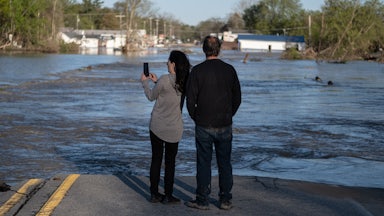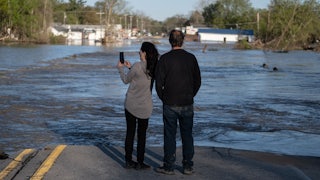In the coming days, some 200 million people across the United States will sweat through temperatures in the high 90s and triple digits, made worse by “oppressive” humidity. It’s the country’s first major heat wave of the year, which may—like last year—turn out to be among the warmest years ever recorded. Last month was the second-hottest May ever recorded; 10 of the hottest years ever recorded on earth have occurred over the last decade.
A study published on Thursday in Earth System Science Data finds that the amount of planet-heating carbon dioxide already emitted into the atmosphere by human activity will very likely, by 2028, have made the world 1.5 degrees Celsius (2.7 degrees Fahrenheit) warmer than it was in preindustrial times. This increase might sound mild on its face, but respected scientists are in agreement about what this means: more brutal, dangerous heat waves like the one spreading across the U.S. right now.
Maybe the most sobering aspect of rising temperatures is how predictable they are. Xuebin Zhang—a co-author of the study, professor at the University of Victoria, and head of the Pacific Climate Impacts Consortium—says that in his decades of research, very little has surprised him about how the planet has reacted to rising concentrations of greenhouse gases in the atmosphere. “The world’s climate is behaving exactly as we said it would all along, for many years. It is warming due to human influence. It gets faster if we don’t act on it,” he told me. “It’s more than beyond a reasonable doubt. It is a fact.”
So what differentiates a couple of hot days from a heat wave caused by climate change? Typically, heat waves are produced by something known as atmospheric blocks, when high pressure settles over a region for days or weeks at a time, causing air to descend and heat up. Since cloud cover is typically low during these periods, more solar radiation can heat up the surfaces below. While there are varying definitions of how long and hot a period of high temperatures has to be to qualify as a heat wave, the answer depends on where you are. Temperatures that are above average for June in New York, for instance, may not be abnormal in Tucson or Karachi.
In order to determine whether such an event can be attributed to climate change, researchers run complex models based on historical observations: one showing the world as it is and the other “an alternative world where there isn’t any human influence on the climate,” said Nicholas Leach, a physicist at at Oxford University who researches weather and climate impacts on health. From there, scientists can determine how likely a specific extreme weather event would be in a world without climate change, i.e., with lower concentrations of human-caused greenhouse gases in the atmosphere. Other studies, Leach says, more specifically replicate the exact atmospheric patterns and conditions that produced a particular heat wave in those two worlds, observing how the intensity and severity of the resulting heat wave would change in a world where human activity isn’t causing temperatures to rise.
It’s generally easier to determine whether climate change has contributed to heat waves as compared to hurricanes, which can vary based on any number of factors in oceans and the atmosphere. “We’re warming up the atmosphere, and there’s a very strong link between doing that and the hottest possible situations getting hotter,” Leach says. “The link between climate change and thermodynamics has been understood for 100 years.”
Researchers are still working on understanding what precisely climate change is doing to the atmospheric blocks that produce heat waves, particularly in the case of extraordinary events when temperatures soar far outside the range of historical observation—like the Pacific Northwest heat wave of 2021, which caused hundreds of excess deaths across the U.S. and Canada. One study found that heat waves that extreme would “occur roughly every five to 10 years” in the same region if global temperature averages were to exceed two degrees Celsius above preindustrial times.
As Nathan Gillett—another co-author of the climate indicators study and a researcher at the Canadian Centre for Climate Modelling and Analysis—told me, the world is already experiencing heat waves that “would have been much less likely or almost impossible without human-induced climate change.” Those heat waves will worsen as humans burn more fossil fuels and continue to raze forests, which is rapidly depleting the planet’s ability to absorb carbon dioxide. The more of it that goes into the atmosphere, the hotter it gets. “There’s very high confidence,” Gillett said, “that, with ongoing greenhouse gas emissions, the world will continue to warm and heat waves will continue to be hotter. That’s going to happen everywhere.”






